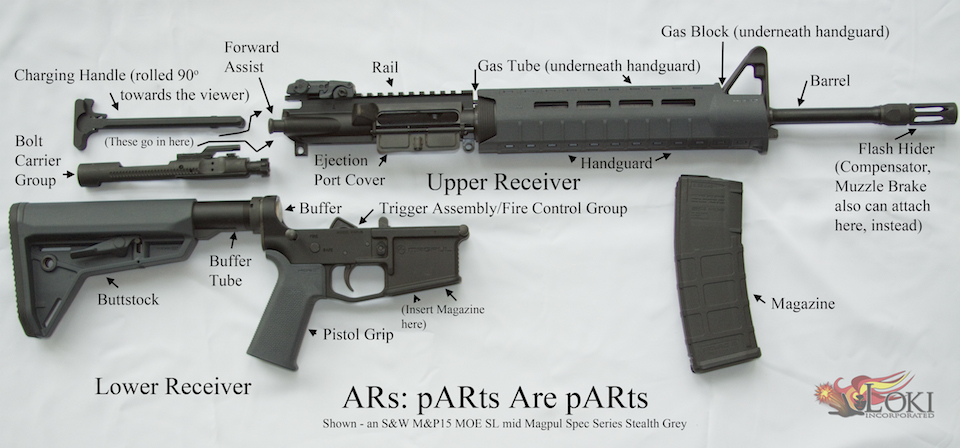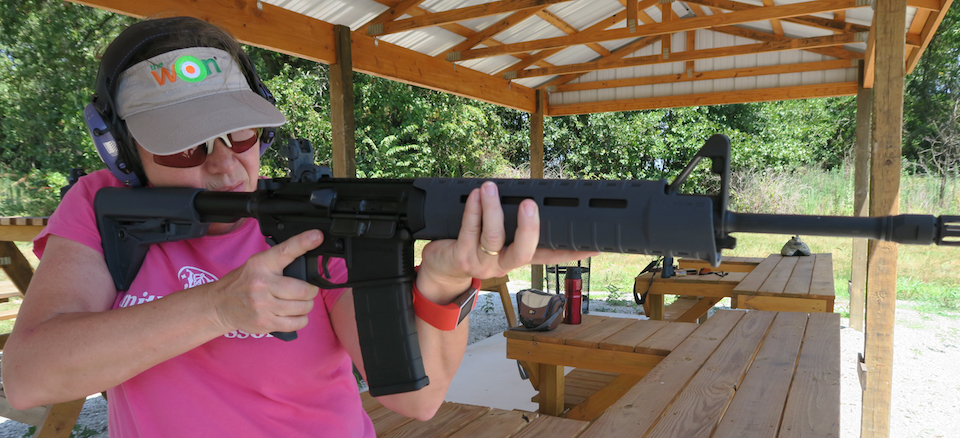All About ARs: An AR-15 Breakdown of Parts
Parts, parts and more parts. If you’re going to be the owner of an AR-15, you need to know about its parts and about an AR-15 breakdown. In this installment of “All About ARs,” we’ll be listing the parts so that you can be educated about this marvelous platform available to gun owners in America. When you know about the parts, you’ll know which ones you might want to swap-out, which ones you can swap-out easily and which ones you can’t. At the time it was created, the AR system incorporated a unique combination of technologies that made it revolutionary in the world of military arms development. It was a gas-operated, pistonless, center fire rifle that made extensive use of aluminum alloys and polymers in a world of steel and wood military guns.

(Jason Baird photo)
AR-15 Breakdown, or ‘pARts Are pARts’
An AR has 2 basic sections, the upper and lower receivers, and each of these 2 sections has sub-units with various parts. For this article, we’re referring to a rifle system colloquially called an AR-15 after the original Armalite and Colt’s patented firearm. There are other rifle types that have AR as part of their names, such as AR-10 and AR-50, and even though Colt’s holds the trademark to “AR-15” we are going to use AR-15. As used by the media and general population, this term covers a large number of guns from several manufacturers.
UPPER RECEIVER
The upper receiver is the section of the rifle that contains the following pieces and attaches to the lower receiver. Here’s the breakdown on it:
- Barrel– It’s good to have at least 16 inches for your barrel, because if it’s shorter than 16 inches, you’ll have to do special paperwork and buy a federal tax stamp for a “Short Barreled Rifle” before you can take possession of it. So, keep it at 16 or longer, and then you can also decide if you want a fluted barrel or another type. In the end located in the upper receiver, the barrel has a chamber for the cartridge, partway down the barrel’s length is a gas port drilled into the bore of the barrel, and at the other end of the barrel is the rifle’s muzzle. The barrel may or may not have a muzzle device (a generic term for a flash hider or muzzle brake or noise suppressor). You may choose different rifling twist rates in barrels if you wish.
- Muzzle compensators– Compensators work with the propellant gases that follow the bullet out of the barrel and vent them in a direction that helps the shooter keep the barrel pointed at the target during recoil. The result is that your barrel stays on target.
- Muzzle brakes– You can shoot fast with an AR, pulling the trigger again and again. This is one reason it is such a wonderful personal defense gun. But, with rapid fire comes rapid recoil and the gun is in a continuous state of flux – up and down. Follow up shots rule in competition, hunting and personal defense situations. Muzzle brakes have been purported to reduce recoil by up to 50%. A muzzle brake vents the gases at an angle to counter-act the rearward action of recoil.
- Muzzle flash hiders– These gizmos usually come on a rifle with standard muzzle threads. Muzzle flash is not something cool to see, except in the movies. It gives away your location, and disturbs your line of sight or your night sight.
- Bolt carrier group– The bolt carrier group contains the firing pin, bolt, cam pin, extractor, ejector and gas key. The bolt carrier group is like boots on the ground here. It loads and unloads and ejects rounds. You can buy one preassembled, buy one in a gun or buy the separate parts and assemble your own.
- Gas block and gas tube– Here’s why you need to know about your AR and gas. Gas pressure from the cartridge just fired is siphoned through the barrel’s gas port into the gas block, where it passes into a gas tube that transfers the hot gas back into the upper receiver. The gas goes from the tube into the gas key, which is attached to the bolt carrier group, and drives the bolt carrier group backward into the buffer tube (a part attached to the lower receiver) against a spring-loaded buffer. As the bolt moves back with the bolt carrier, it extracts the fired cartridge from the chamber and ejects it out of the rifle. When the bolt carrier group comes to a stop against the buffer, the buffer’s spring recoils and drives the bolt carrier group forward, which grabs a new round off the top of the magazine and forces it into the chamber – ready for you to pull the trigger and send a bullet downrange again. Gas also propels that bullet down the barrel. The gas system is located under the handguard and above the barrel. In fact, there are 5 gas system lengths, designated by the position of the gas port within the barrel: rifle-length, intermediate-length, mid-length, carbine-length and pistol-length. Most of the time, you’ll find the gas block inside the handguard area, in the barrel. The gas tube is connected to the block and upper receiver.
- Charging handle– If you’ve ever racked a slide back on a handgun, you’ll understand why you need a charging handle on an AR. Located at the back end of the upper receiver area, this is what you pull back toward your body when you want the bolt carrier group to extract and eject a bad cartridge or piece of ammo, or to reload a new cartridge into the chamber. You can also load when the carrier group is forward against the chamber by pulling the handle back and letting it go forward. Always remember to slide the handle back into place, lock it in place and listen or feel the resulting click. The charging handle doesn’t move, though, during firing.
- Forward assist– To some, this is like your appendix – not necessary, and some ARs don’t have one. The forward assist will allow you to close the bolt completely, if it’s hanging up. It’s a back-up.
- Handguard– The designers created ARs to be supported by the non-trigger-pulling hand, so the guns have a handle called a handguard or forend that surrounds the barrel for the shooter’s support hand. ARs get hot fast. You can imagine how hot the barrel and gas tube of an AR get with repeated firings, so the handguard allows you to support the rifle in various ways without burning yourself. One tip to remember – the gun’s forend must be long enough to cover the gas system above your AR’s barrel.
- Foregrips– These additions may be installed underneath the handguard, either vertically or at an angle, and it’s up to you and your shooting preference.
- Ejection port cover– Most, but not all ARs have one of these. This cover should be closed when you’re not having to show open and make clear, lay the gun down on a range bench, etc. It opens on its own when you fire a round, but overall, is intended to keep foreign objects and dust out of your gun’s chamber area.
- Rail – Also called a Picatinny rail after the U.S. Army arsenal in Picatinny, New Jersey, where the rail dimensions were standardized for the military, this part (and it seems like all ARs come with 1 or 2) can be attached to the upper receiver and/or the handguard and allows you to accessorize your gun with lights, lasers, optics, but not cup-holders.

(Jason Baird photo)
LOWER RECEIVER
The lower receiver is the serial numbered part of the gun that is defined by the ATF as the firearm. That’s why it is the only part that you must purchase through an FFL or through a private purchase; everything else you can buy online or in stores. The lower receiver either carries or has the following parts attached to it:
- Trigger assembly/fire control group – Comprised of the trigger and its associated springs, disconnector, fire selector/safety and hammer, the force required to release the trigger (so-called trigger weight) can be adjusted with some triggers to suit your needs. If you have a trigger unsuitable for you, you can replace it with an aftermarket model. Anything less than 4 pounds is considered light.
- Buffer tube / buffer– As its name infers, this piece – the buffer – absorbs some of the recoil of your AR. The buffer tube connects to the rear of the lower receiver, holds the buffer and buffer spring, and is the support for the butt stock. See the above description of the gas block and gas tube for information about how the buffer works in the gun’s operation.
- Butt stock– This is the part of an AR that works with you so that you can fire the gun effectively. The butt stock may use the buffer tube as its main support (collapsible stocks) or just incorporate the buffer tube within (fixed stocks). You brace this part of the gun against your shoulder, and it fits between your shoulder and the working parts housed in the lower receiver. You may choose from a fixed or collapsible stock. A collapsible stock allows you to fit the gun to your shoulder and reach all its parts conveniently, no matter how long your arms may be or how much clothing you are wearing.
- Magazines– The most important thing about magazines – those holders of cartridges made of metal or polycarbonates – is that you know the laws of the state where you are shooting and/or storing the gun. Some states only allow a 10-round magazine, while others allow a lot more. Always have more than 1 magazine to work with, because if you’re experiencing some malfunctioning problems, the magazine is always one of the first things you change.
- Pistol Grips– This grip attaches to the lower receiver. It’s your connection to the gun with usually your strong shooting hand, and there are many options. Grooves, no grooves and angles or no angles.
You can build your own AR, or buy it completely built in stock, or have someone build it for you. That’s one of the major beauties of this platform.
In our next installment, #3, we’re going to look at furniture and talk about how you can change it on an AR. It also involves a breakdown of parts.
Visit part 1 of our series, All About ARs.
-

About Barbara Baird
Publisher/Editor Barbara Baird is a freelance writer in hunting, shooting and outdoor markets. Her bylines are found at several top hunting and shooting publications. She also is a travel writer, and you can follow her at https://www.ozarkian.com.
View all posts by Barbara Baird →

